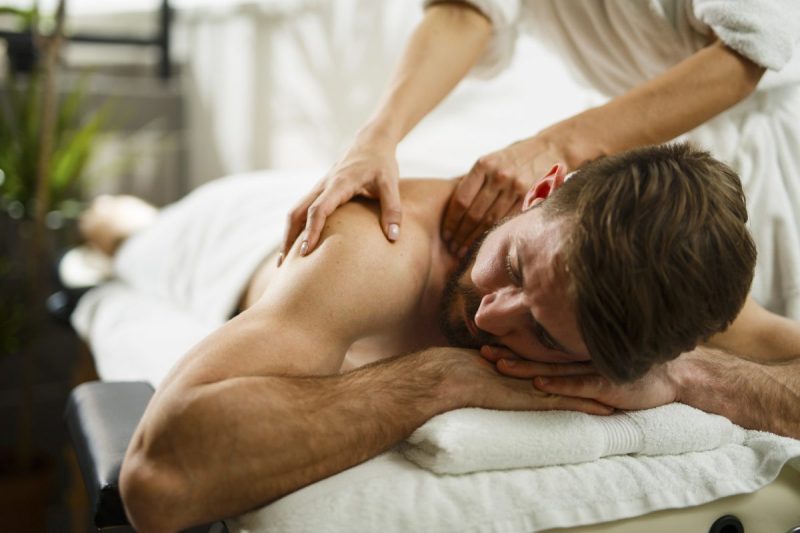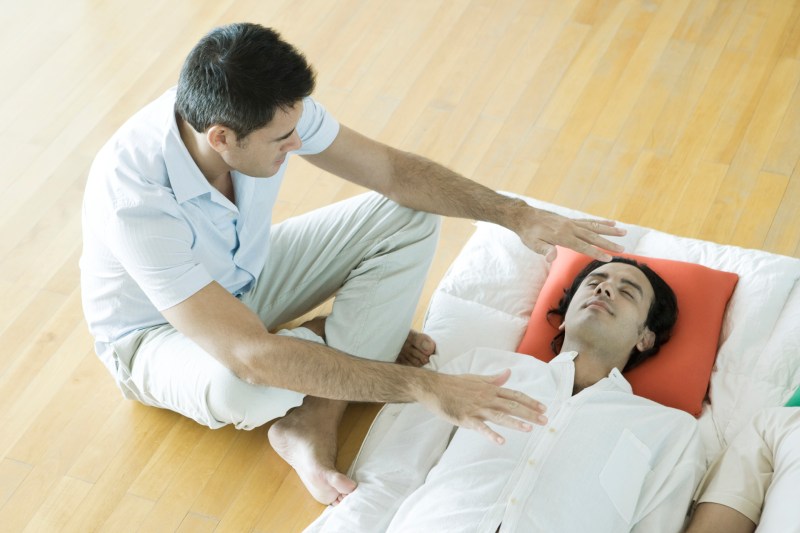
Most of the time, the doctor is the best person to visit when your body gives you problems. But every now and then, the doctor comes up short on answers. That is to say, they tell you there’s nothing wrong with you, despite the symptoms you’ve described in detail.
As a guy, you’re a lot less likely to experience a doctor’s dismissal than a woman is. But when it happens, it’s incredibly frustrating. Especially when the problems you’re describing — mysterious aches and pains, ongoing digestive problems, unwarranted fatigue — are brushed off with a statement like, “Well, you’re not getting any younger.”
Thanks for the advice, Doc. We all know that the aging process can’t be stopped. What more guys really need to be told is that many physical ailments, including those brought on by aging, can be treated quite effectively with the right type of bodywork.
You’ve probably already heard about certain forms of bodywork, such as massage or acupuncture. If you’re lucky enough to have a kooky relative or two, you might even have heard of forms like Reiki or reflexology. While some modalities are more woo-woo than others, part of what makes bodywork so effective is that it seeks all possible sources of a given physical issue. If you just keep an open mind, you’ll find that sometimes the most out-there forms of bodywork provide the most profound relief for your muscles and joints, and (as a side benefit) for the thoughts and emotions that men often pride themselves on keeping to themselves.
If you only take your car in when something major falls apart, the vehicle is going to break down a lot faster. But if you take it in for regular tune-ups, the old whip will run a lot longer and a lot sweeter. The same principle holds true for your body. So don’t let your constipated machismo get the better of you — pop up on a table and let your consciousness sink into theta-wave state while a trained professional clears your energy channels and recharges your life force. Worst case scenario, you’ll bliss out for an hour. Best case, you’ll leave feeling a whole lot better.
Massage

While few guys would turn down a massage offer from a lovely lady friend, a surprising number are skittish when it comes to getting it done professionally. But what your lady friend might not know is how certain levels of pressure at certain points can not only help you relax, but also stimulate lymphatic drainage, release areas of chronic tension, and stimulate circulation. Seek out forms like Shiatsu and Thai massage if you’re trying to improve your digestion, increase your range of motion, or combat stress and fatigue. Swedish or deep tissue massage is ideal if you’re trying to lose weight, get over illness, or overcome chronic pain.
Acupuncture
Acupuncture needles are inserted in points that are located on “channels” or “meridians” that flow through the body carrying energy, blood, and nourishment. Inserted at these points, needles adjust the flow to help the body rebalance and become healthier. Acupuncture is not painful, though you may feel a sensation when the needles are inserted. You also might feel heaviness, tingling, warmth, or a sensation of movement along the acupuncture channel. Once you get used to the sensation, though, you’ll be shocked by how relaxed you feel during the treatment. And unlike massage, where you feel sort of drowsy or floaty after getting up from the table, acupuncture sends you home feeling super-energized.
Acupuncture is beneficial for just about any physical malady, such as chronic illness, back pain and other injuries, or digestive disorders. While you might feel relief after just one session, it usually takes about five acupuncture sessions to create long-term results.
Trigger Point or Neuromuscular Therapy
You know those little knots of soreness that seem to hang out in your neck, shoulders, and back, no matter how much you stretch or how long it’s been since your last injury? Those are the trigger points, and they consist of tightly contracted muscle that affects a tiny patch of tissue, but can create pain that spreads through other parts of the body. Trigger point therapy involves applying steady pressure to those little knots to release the contraction and deactivate the trigger, so your muscles can get back to business as usual.
Chiropractic

Chiropractic is more than just “back cracking” — the idea is that proper alignment of the body’s musculoskeletal structure helps the body itself without surgery or medication. When performed by a well-trained, certified provider, chiropractic can overcome issues that down the road might require medication or even surgery. (When given the choice between hands or a knife exploring our spine, we’ll take the former, thank you.) While typically not as relaxing as other forms of bodywork (there’s a lot of pushing, popping and pressure), seeing a chiropractor on the regular can help treat not only low back pain but also migraines/tension headaches, fibromyalgia, gut and immune issues, as well as improving your overall flexibility and functionality.
Myofascial Release
Very similar to trigger point therapy, myofascial release takes the pain relief one step further by following the area of restriction back to where it originated. In a way, it’s like foam rolling a sore muscle or joint, only done by a trained practitioner who effectively “unwinds” your physical issue from origin point to the symptomatic area, usually sustaining pressure for 5 to 7 minutes at a time. Each session not only relieves pain and dysfunction, but helps elongate the body’s fascia (bands of connective tissue that attach and stabilize muscles and organs) so that you’re more flexible, balanced, and injury-resistant.
Visceral Manipulation
Conceived in the 1980s by a French osteopath, visceral manipulation consists of very gentle abdominal massage intended to gently compress and move certain soft tissues, with the goal of healing scar tissue and stimulating organs to release constriction. It’s said to improve issues such as constipation, post-surgical adhesions, back pain, stress-related mood disorders, and sleep problems.
Reflexology

Reflexology is focused exclusively on the feet, hands, and ears, based on the principle that the those parts of the body contain the ends of energy meridians. The idea is that by stretching and applying pressure to strategic areas on these extremities, you can send a calming message to the central nervous system, signaling the body to dial down the tension, stimulate organs to step up their performance, promote circulation, and generally help the body heal itself.
Structural Integration or Rolfing
This technique uses deep manipulation of the body’s fascia to realign and balance the body’s structure with the field of gravity. Older Rolfing patients in particular swear that it’s the most effective “anti-aging” form of body work — it literally helps your body fight gravity. Rolfing is a go-to for issues like back pain, posture issues, TMJ, and breathing issues such as asthma. It’s also very popular with pro athletes for improving their performance. (Just ask Rolfing devotees like NBA coach Phil Jackson, forward Charles Barkley, and Olympic figure skater Michelle Kwan.) Traditionally, Rolfing requires a set of ten sessions done in a specific series.
Craniosacral Therapy
Developed in the 1970s, this therapy is a very gentle method of evaluating and enhancing the function of the craniosacral system … which, if you didn’t know, consists of the membranes and cerebrospinal fluid which surround and protect the brain and spinal cord. During a session, the practitioner will apply extremely gentle pressure to the skull, spine, pelvis, and other areas, provoking a self-healing response from your body. You may feel a deep sense of relaxation, find old memories resurfacing, or even feel your body moving on its own initiative. It’s very effective for relieving symptoms from old injuries, as well as shedding emotional trauma and chronic stress and releasing the root cause of behavioral and mood disorders.
Reiki

Reiki, a combination of two Japanese words that together mean “spiritually guided life-force energy,” is a technique for stress reduction and healing relaxation. Based on the idea that an unseen energy is what creates and sustains life, Reiki is intended to bolster that energy so that you find it easier to be healthy and happy. During a Reiki treatment, the practitioner will hover their hands over your clothed body (usually without touching you) and perform a pushing or sweeping motion intended to clear stagnant energy fields caused by physical or emotional pain. As kooky as it might sound, a treatment can fees like a wonderful glowing radiance that flows through and around you. Reiki treats the whole person including body, emotions, mind, and spirit, creating many beneficial effects that include relaxation and feelings of peace, security, and well-being.


